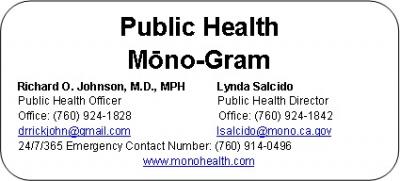Mono-Gram - Pertussis
June 10, 2014
Rise in Pertussis Cases
The California Department of Public Health (CDPH) has received reports of 1,711 cases of pertussis occurring from January through April 2014, more than triple than the number of cases in the same period last year. Fortunately, none have been reported in the Eastern Sierra.
Pertussis peaks in incidence every 3-5 years. The last peak in California was in 2010, and now we are concerned that the recent increase in reported cases suggests that another cyclical peak is beginning.
Infants too young to be fully immunized remain most vulnerable to severe and fatal cases of pertussis. Most of the 77 hospitalized cases to date in 2014 have been in children three months of age or younger. This year’s two pertussis deaths, the first reported in California since 2010, occurred in infants. To prevent severe pertussis in infants, CDPH recommends that pregnant women receive a pertussis vaccine booster during the third trimester of each pregnancy, and that infants be vaccinated as soon as possible.
More than 90 percent of this year’s reported pertussis cases have been in children younger than 18 years of age, including 32 percent who were 14 through 16 years of age. Outbreaks of pertussis in elementary, middle, and high schools have been reported throughout the state.
It’s important that both children and adults are up-to-date on their immunizations. Booster shots for pertussis are critical because, unlike some other vaccine-preventable diseases, neither the pertussis disease nor vaccine confers lifelong immunity.
To prevent pertussis, we recommend that:
- Pregnant women receive a pertussis vaccine booster during the third trimester of each pregnancy, even if they’ve received it before.
- Infants should be vaccinated against pertussis as soon as possible. The first dose is recommended at two months of age but can be given as early as 6 weeks of age during pertussis outbreaks. Children need five doses of pertussis vaccine by kindergarten (ages 4-6).
- California 7th grade students receive the pertussis vaccine booster as required by state law.
- Adults receive a one-time pertussis vaccine booster, especially if they are in contact with infants or if they are health care workers who may have contact with infants or pregnant women.
Note: The Mono County Health Department has available doses of pertussis vaccine for $10 that can be used to vaccinate pregnant women. It also can be used to vaccinate all other family members who need vaccine, creating a “cocoon” of protection around the new baby. Please call for more information or for an appointment.
The symptoms of pertussis vary by age. For children, a typical case of pertussis starts with a cough and runny nose for one to two weeks. The cough then worsens and children may have rapid coughing spells that end with a whooping sound. Young infants may not have typical pertussis symptoms and may have no apparent cough. Parents may describe episodes in which the infant’s face turns red or purple. For adults, pertussis may simply be a cough that persists for several weeks. More information about pertussis is available on the CDPH website.


